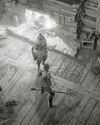
Game developers are used to a complicated sense of ownership. The designer who conceives a game in preproduction might not be the same who sees it to completion; the publisher to whom the IP legally belongs may never touch its code. Yet for the team at Crytek Frankfurt back in 2013, the answer was unusually clear: Hunt wasn’t theirs.
Hunt: Horrors Of The Gilded Age, as it was known then, lived on another continent. As THQ collapsed, Crytek’s Cevat Yerli had swooped into Austin, Texas to hire Vigil head David Adams, and subsequently many of the studio’s former staff. Hunt would be the next step for the Darksiders team: an action-RPG reshaped by the added contemporary twist of four-player co-op. It was even developed on the same computers as Darksiders – in a practical gesture of continuity, Crytek had bought those too. “We received updates through monthly team company meetings,” recalls Crytek Frankfurt’s Dennis Schwarz. “I was always curious to see the next steps and how this whole thing evolved. But obviously, we weren’t a part of the development process.”
Until, that was, Hunt’s dramatic origin story took a further turn. 2014 turned out to be the most traumatic year in Crytek’s history. After a period of rapid growth that peaked with nearly 1,000 staff across nine studios, the company was entering a phase of painful contraction. With employees left waiting for pay, Crytek sold off Homefront: The Revolution and its veteran UK developer. The former Vigil team, meanwhile, was stripped to the bones, reduced to providing engine support for local CryEngine licensees.
This story is from the {{IssueName}} edition of {{MagazineName}}.
Start your 7-day Magzter GOLD free trial to access thousands of curated premium stories, and 9,000+ magazines and newspapers.
Already a subscriber ? Sign In
This story is from the {{IssueName}} edition of {{MagazineName}}.
Start your 7-day Magzter GOLD free trial to access thousands of curated premium stories, and 9,000+ magazines and newspapers.
Already a subscriber? Sign In

NO MORE ROOM IN HELL 2
You're not alone in the dark

WINDBLOWN
Life after Dead Cells

COLLECTED WORKS - JOSH SAWYER
Journeying to the Forgotten Realms, Infinity and beyond with the RPG veteran

SCREENBOUND
Going deep in a mind-bending hybrid of perspectives

Trigger Happy
Shoot first, ask questions later

Grand strategist
Paradox's Mattias Lilja addresses the publisher's recent difficulties - and the plan to right the ship

Diablo IV
A progress report on the games we just can't quit

Ghosts 'n Goblins Resurrection
In Capcom's diabolical tribute, evil goes far deeper than the demons on the screen

SERENITY FORGE
How a near-death experience lit a fire in the Colorado-based developer and publisher

THE MAKING OF...ALIEN: ISOLATION
How a strategy-led studio built a survival horror masterpiece in Ridley Scott's image